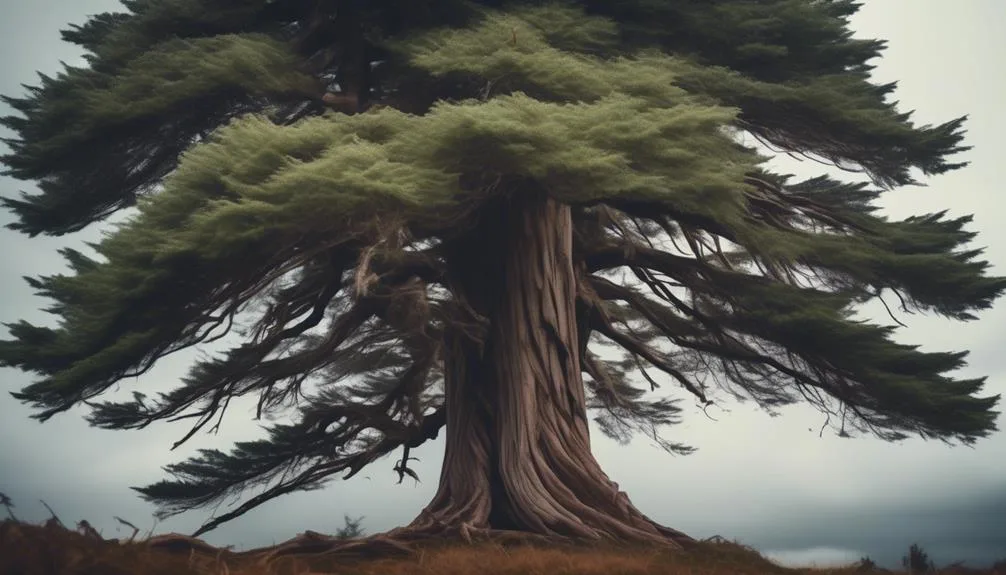Are cedar trees really able to withstand strong winds? There's been some debate, but the truth is, cedar trees can handle high winds.
How do they do it? Understanding their resilience can help us care for these magnificent trees in windy conditions.
What are their secrets to withstanding wind? Let's explore how cedar trees manage to thrive in blustery weather.
Understanding Cedar Tree Adaptations
To thrive in high winds, cedar trees have developed a remarkable set of adaptations that allow them to withstand and even flourish in challenging environmental conditions.
Their root systems play a crucial role in providing stability, as they extend deeply into the ground, anchoring the tree securely. This enables cedar trees to resist being uprooted during storms and strong winds.
Additionally, their ability to form dense stands makes them effective windbreaks and shelterbelts, providing protection to other plants and creating microclimates that are more conducive to growth.
The intertwined branches and foliage also contribute to their stability, reducing the impact of strong winds.
These adaptations not only allow cedar trees to survive in high winds but also make them valuable in protecting and enhancing the environment around them.
Factors Affecting Cedar Tree Wind Resistance
Cedar trees' wind resistance is influenced by various factors, stemming from their remarkable adaptations to thrive in challenging environmental conditions.
- Root Structure: Cedar trees develop a deep and extensive root system, anchoring them firmly into the ground and providing stability during high winds.
- Branch Flexibility: Their branches are designed to sway and bend with the wind, reducing the risk of breakage or uprooting.
- Crown Density: The density of the tree's crown affects its wind resistance. A more compact crown reduces wind drag, enhancing stability.
- Genetic Modification: Research explores the potential for genetic modification to enhance cedar trees' wind resistance, aiming to develop stronger, more resilient varieties.
Advancements in wind tunnel testing and genetic modification offer valuable insights into improving cedar trees' ability to withstand high winds, providing hope for more robust and resilient forests.
Best Practices for Planting Cedar Trees
When planting cedar trees, ensure the selected location offers well-drained soil and receives ample sunlight for optimal growth and resilience.
Begin by preparing the soil. Cedar trees thrive in well-drained soil, so amend heavy clay or poorly draining soil with organic matter to improve drainage.
Before planting, water the tree in its pot thoroughly.
When placing the tree in the ground, dig a hole twice as wide as the root ball but no deeper. Gently remove the tree from its container, ensuring the roots remain intact.
After planting, water the tree deeply and then regularly, especially during the first year. Watering techniques play a crucial role in establishing the tree, so monitor the moisture levels and adjust watering as needed to promote healthy growth.
Maintaining Cedar Trees in Windy Conditions
In windy conditions, it's essential to ensure the stability of your cedar trees for their continued health and resilience. Here are some crucial steps to maintain your cedar trees in windy conditions:
- Windbreak strategies: Planting windbreaks such as shrubs or erecting fences can help reduce the impact of strong winds on your cedar trees by creating a barrier.
- Soil erosion prevention: Wind can cause soil erosion around the base of cedar trees, leading to instability. Mulching and planting ground cover can help prevent soil erosion and maintain the stability of the trees.
- Pruning: Regular pruning can help remove weak or damaged branches, promoting a more stable tree structure that can better withstand windy conditions.
- Support systems: Installing support systems such as stakes or guy wires can provide additional stability to cedar trees in windy areas, reducing the risk of damage.
Enhancing Cedar Tree Wind Tolerance
To enhance the wind tolerance of your cedar trees, regularly assess their structural integrity and consider implementing reinforcement measures to fortify their resilience against strong winds. Utilize pruning techniques to remove weak or damaged branches, promoting a more streamlined shape that reduces wind resistance. Additionally, proper soil preparation and root development are crucial for enhancing wind tolerance. Ensuring that the soil is well-drained and rich in nutrients will encourage strong, healthy root systems that anchor the tree securely. When designing a windbreak, consider the layout and density of surrounding vegetation to create a protective barrier. Here's a breakdown of key factors to enhance cedar tree wind tolerance:
| Key Factors | Description |
|---|---|
| Pruning Techniques | Remove weak or damaged branches to reduce wind resistance |
| Soil Preparation | Ensure well-drained, nutrient-rich soil for strong root development |
| Windbreak Design | Strategically plan surrounding vegetation to create a protective barrier |
Conclusion
In the face of strong winds, cedar trees thrive, thanks to their flexible branches, deep roots, and natural adaptations. Understanding wind resistance factors, proper planting, and maintenance can enhance their tolerance.
How can we continue to support these resilient trees for a sustainable future?

My interest in trees started when I first saw the giant sequoias in Yosemite.
I was a teenager then, and I remember thinking, “I need to learn more about this.”
That moment stuck with me.
A few years later, I went on to study forestry at Michigan Tech.
Since graduating, I’ve worked in a mix of hands-on tree care and community education.
I’ve spent over ten years helping people understand how to plant, maintain, and protect the trees in their neighborhoods.
I don’t see trees as just part of the landscape.
They are living things that make a real difference in our daily lives.
